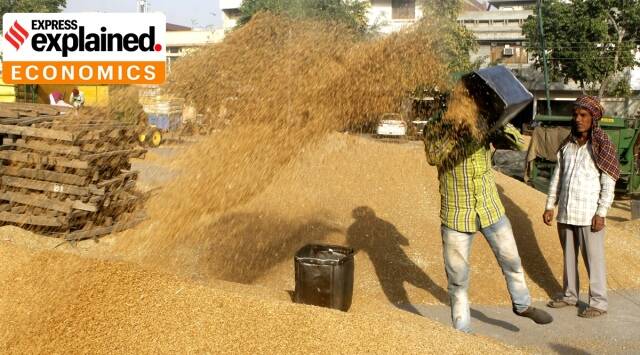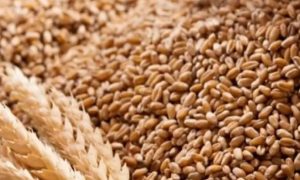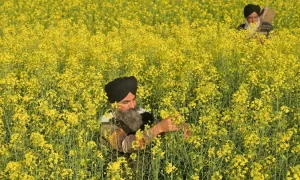Why wheat procurement figures are good news for food security and inflation

It seems the March rain has not damaged the rabi crop as much as had been initially feared. Wheat stocks will fill godowns and take the load off rice, the prospects of which are under the shadow of a May-July El Niño.
Wheat procurement by government agencies is set to cross 25 million tonnes (mt) in the current rabi marketing season. With the crop continuing to arrive in the mandis and cumulative purchases, at 21.31 mt as on Friday, having already surpassed the 18.79 mt bought during the entire 2022 season (April-June), policymakers would be relieved on at least two counts.
The first has to do with production.
Last year, a spike in temperatures during March — when the crop was at the grain formation and filling stage — had severely impacted wheat yields. This year, the second half of March saw unseasonal rain accompanied by high winds, causing the wheat plants to “lodge” (bend over or even fall flat) in many places.
Limited yield losses
But the fact that both market arrivals and procurement have been higher compared to last year is perhaps proof that the crop has not suffered as much damage as was initially feared. The Punjab government’s agriculture department has assessed average wheat yields in the state at 47.2 quintals per hectare — more than last year’s 42.17 quintals, even though less than the 50.08, 51, and 51.88 quintals in the preceding three years. The crop is, thus, below normal, but better than in 2022.
Government wheat purchases of 18.79 mt last year weren’t just below the all-time high of 43.34 mt of 2021, but also the lowest since the 11.13 mt of 2007.
The result was that the Food Corporation of India’s (FCI’s) godowns did not have much wheat to meet the requirements of the public distribution system (PDS) and other government schemes, including mid-day meals in schools and open market sales for cooling prices.
The data shows the total offtake of foodgrains from government stocks during the last three financial years (April-March) was between 93 and 106 mt. This was well above the annual average of 62.5 mt during 2013-14 to 2019-20, the first years after the National Food Security Act (NFSA), 2013 came into force.
The increase in offtake was largely on account of the Pradhan Mantri Garib Kalyan Anna Yojana (PMGKAY), which doubled the subsidised grain allocation for the 813.5 million persons covered under the NFSA from 5 kg to 10 kg per month.
Rice does the heavy lifting
Wheat being in short supply after last year’s failed crop, the burden of feeding the PDS has fallen disproportionately on rice. The offtake of rice from the Central pool during 2022-23 hit a record — both in absolute (63.8 mt) and relative (68.9% of total) terms.
Wheat offtake fell by nearly 43% last year vis-à-vis 2021-22. But even after that, stocks of the rabi cereal depleted to a seven-year-low on April 1 — at 8.35 mt, these were just a shade above the normative minimum of 7.46 mt at the start of the new marketing season, necessary to cover both PDS operations and any procurement shortfall.
First, it will help replenish the much-depleted stocks of wheat. The discontinuation of the 5-kg additional grain quota per person per month under PMGKAY after December 2022 should, in the normal course, bring down the total Central pool offtake to within 65-66 mt.
The government has targeted wheat purchases for this season at 34.15 mt, which seems a tall order. But even if procurement touches 25-26 mt — which looks realistic — it can meet about 40% of the reduced overall offtake requirement.
Risks from bad rains
Second, more wheat in government godowns would take the load off rice to that extent. This may also be necessary in view of the chances of a not-so-great monsoon this year following four consecutive good rainfall years from 2019 to 2022. The US National Oceanic and Atmospheric Administration (NOAA) in its recent update has predicted a 62% probability of an El Niño developing during May-July 2023.
Given the past association of failed southwest monsoon seasons (June-September) in India with the abnormal atmospheric wind and sea surface temperature variability phenomenon over the equatorial Pacific, policymakers would need to brace for a subnormal 2023 kharif harvest. This could particularly impact the production of rice, which was the mainstay of the PDS last year. That level of heavy lifting cannot be expected from rice this year.
But prices pressures could ease
Third, wheat procurement and production being more than last year should go some way in cooling cereal inflation. Retail prices of cereals rose 15.27% year-on-year in March, higher than the corresponding 5.66% general consumer inflation for the month. Government grain stocks have overall been comfortably above the buffer levels only thanks to rice. The wheat from this year’s procurement will provide an additional layer of comfort.
All this — plus the fact that global food prices have come off more than a fifth of their March 2022 peaks after Russia’s invasion of Ukraine — should bring some respite to the government and the Reserve Bank of India. The tenure of the Narendra Modi government has witnessed episodic price spikes in pulses (2015-16), onion (2015 and 2017-18), edible oils (2021-22), and wheat and milk (2022-23). Nothing gives a ruling party the jitters more than food inflation closer to elections — in this case, March-April 2024.














